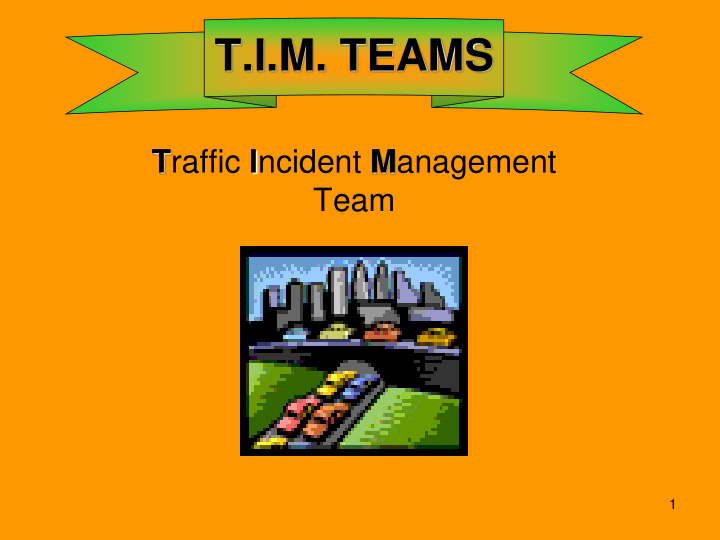



T.I.M. TEAMS T raffic I ncident M anagement Team 1
Why T.I.M. TEAMS? • Over 50% of the congestion is caused by non- recurring incidents. • For every additional minute taken to clear a traffic incident, it will extend the duration an additional 4 to 7 minutes. • Teamwork among emergency service agencies is imperative , if we are to enhance traffic incident management. 2
AGENCIES TO BE INCLUDED IN T.I.M. TEAMS • Fire & Rescue (City & County) • Law Enforcement (City, County & State Patrol) • Hazardous Materials Units (City, County & Commercial) • Towing & Recovery • Medical Examiner • Road Ranger • DOT • Medical Services • Others 3
T.I.M. TEAMS REMEMBER! The success of an T raffic I ncident M anagement Team starts with the selection of responsible and responsive members. Members should represent their agencies and have the authority to make decisions and commit their agencies to a course of action. It is also important to select a responsible Team Leader or facilitator. 4
BENEFITS OF AN EFFECTIVE T.I.M. TEAM The Benefits are both Quantitative and Qualitative 5
QUANTITATIVE • Increased survival rate of crash victims • Reduced traffic delay • Improved response time • Improved air quality • Reduced occurrence of secondary incidents • Improved safety of responders, crash victims and traveling motorists • Reduced clearance & recovery time 6
QUALITATIVE • Enhanced traveler information • Increased driver warning capabilities • Improved coordination among response agencies • Improved public perception of agency operations • Reduced driver frustrations 7
EFFECTIVE TRAFFIC INCIDENT MANAGEMENT PRACTICES will: • Increases operating efficiency • Reduces the time to detect & verify an incident occurrence • Enhances the safe clearing of an incident, while managing the affected traffic flow until full capacity is restored. • Expedite “Back In Service” time for emergency service units 8
T.I.M. TEAMS Can be an excellent tool for enhancing Coordination , Communications and Cooperation between various agencies within a local jurisdiction. 9
PURPOSE OF T.I.M. TEAMS • Create a dialogue for better inter-agency cooperation. • Create an opportunity for multi-agency training which promotes teamwork. • Create a tool for developing common operational strategies. • Create better understanding of other agencies and their responsibilities. • Create practices that may, not only help their local jurisdiction but also the regional area. 10
GOALS & OBJECTIVES • Adopt a “Open Roads” policy – 90 Minute Clearance Goal • Conduct Training Exercises – Scene planning and training should be conducted. • Conduct Post-Incident Debriefings – Post-Incident debriefings should be held to assess what did and did not work during recent major traffic incident response. • Conduct Special Events Planning – T.I.M. Teams should also plan for special event incident response, such as, planning for major sporting events, concerts, conventions, weather- related events, homeland security and others. 11
SUMMARY T.I.M. Teams cannot be successful unless there is a cooperative attitude among the agencies involved. The working relationship among the various local agencies is critical to its success. T.I.M. Teams can bring together representatives from the various agencies involved with, or affected by, transportation incidents. 12
T.I.M. TEAMS Any Questions 13
Recommend
More recommend